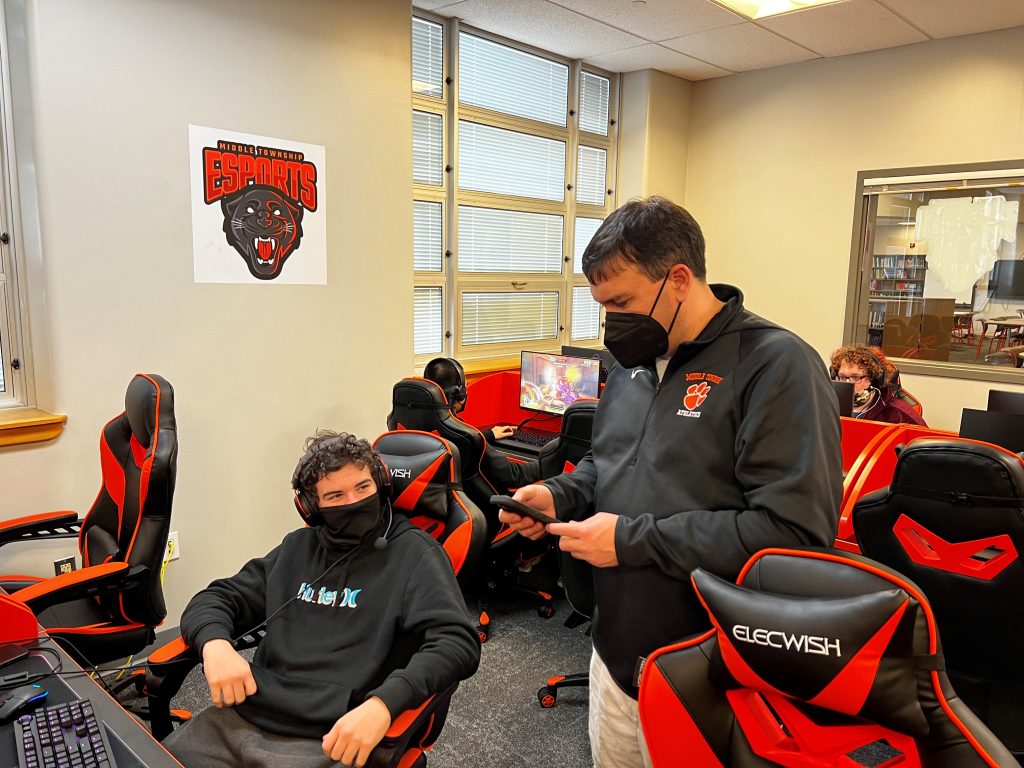COURT HOUSE – There’s more to it than just a group of students playing video games after school, Bud Morey, the coach of Middle Township High School’s new esports program insists.
Inside the school library exists a back room filled with state-of-the-art gaming computers, different gaming consoles, and, every day after school, the sounds of happy children. The room’s equipment is evidence of the high school’s financial commitment to the evolving “sport,” if it can even be called that.
“It’s a gray area. It’s a club, it’s an activity, it’s a sport,” Morey said in an interview, as his team participated in an interscholastic competition, part of a fledging Garden State League the school joined, which is now up to 131 clubs and says it is in 25% of the state’s school districts.
Esports might make traditionalists cringe, but there is no denying it is a world that is gaining momentum, and with that, providing increasing opportunity. According to Morey, that helped school administrators to get on board. While supply chain issues delayed the equipment’s arrival, by January things were up and running.
“They wanted to jump on the tidal wave that’s happening for esports,” Morey said of the school’s support. “They see scholarships going out from schools. Stockton is one of the number one programs in the country right now.”
Esports is essentially organized video game competition. Stockton is far from the only college offering esports opportunities, and professional leagues with mass audiences have seen serious investments, both from financial backers and gambling partners.
At the high school level, schools play each other from their own headquarters, and some teammates even opt to play from home. There is no bussing or traveling involved in interscholastic competition. They communicate both with teammates and opponents over headsets and text chats.
Two games were being played the day of the Herald’s visit: A first-person shooter game called Overwatch, against Oakcrest High School, and, against Franklin Township High School, Rocket League, a game where players drive cars into a giant soccer ball, trying to get it into their opponent’s net, inside an arena that is reminiscent of a bubble hockey rink. Morey said they will also be playing Valorant and Super Smash Bros. in the spring season.
While screams inside a school of “Shoot him! Shoot him!” might raise some eyebrows, and no school basketball team would allow a player to have “Killer” printed on the back of their jersey, a word one remote esports competitor used in their handle, Morey said the school does ban more violent games, like Call of Duty.
For now, players are expected to practice, though that is not necessarily as a group or at an organized time. Morey said in the spring there will be more organized practices.
“This season, they have been practicing on their own. They can get on at 10 at night. Primetime is 10 to 3 in the morning for this stuff,” he said.
Morey rejected the notion that esports programs are low-hanging fruit for those who feel other areas of schools are badly underfunded. He said he has only gotten positive feedback since the inception of the program.
“Now, there is actually curriculum behind it,” Morey said. “You can actually develop class within the school day that you can even teach, and have learning objectives, just like you’re teaching another elective.”
The curriculum exposes players to four categories – strategists, organizers, entrepreneurs, and content creators – giving them skills that can become useful in a spectrum of outlined professional positions, according to a National America Scholastic Esports Federation diagram that Morey provided.
“I actually just met with the National Guard (Feb. 15) and they wanted to talk just to let these kids know that you can translate these esports and this gaming into professions that are in the military, which is like working with drones and robots and coding,” Morey added.
It also brings students like Austin Samselski, one of the Middle Township team members, together with other students, creating unlikely friendships that reach beyond the confines of the esports lounge, when otherwise they might have been home playing games alone.
“I didn’t know anybody going into this. I think maybe only two of them knew each other,” Samselski said. “If you’re interested in esports, it’s a great opportunity to get more friends and meet new people quickly.”
Some criticize esports programs because they take the place of athletics for students who would have otherwise joined a more active, traditional sport had the program not been available as an alternative.
Obesity rates in U.S. children ages 12-19 were over 21% in 2017-2018, according to the latest numbers from the Centers for Disease Control and Prevention. There has been a conscientious push by educators to make school food healthier and get kids more active. Athletics has been a major part of this picture.
“You’re not going out and running laps, but these games are chosen because they are strategic games. You have to have a plan of attack when you’re playing these games. You can’t just go out there and play, and it’s a team game, it’s not just one individual playing,” Morey said.
To contact Shay Roddy, email sroddy@cmcherald.com.








